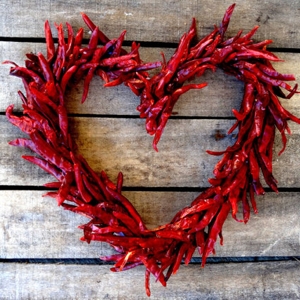‘Spicy’ is a hot topic these days. It has been for a while, actually. And it’s demonstrated the staying power it takes to qualify as a genuine culinary trend. But how much do you know about the biochemistry at the root of the matter?

Aside from good, old Black Pepper, the stuff that makes ‘spicy’ food spicy is always some form of chili pepper. And there are many varieties, spanning a ‘heat’ range from zero to over 2 million Scoville Units.
If that wasn’t amazing enough, chilis come in all sizes, shapes and colours.
But the reason we love them is concentrated in a specific chemical compound.
The ‘hot’ behind the heat
That key chemical compound is capsaicin. It’s what makes all chilis hot. And it’s found mainly in the white internal ribs and seeds of the peppers.
Capsaicin has a peculiar effect on the taste buds. But it delivers other benefits, as well. The stuff is used in small amounts in creams made to treat skin irritations, muscle and joint pain, backp[ain, strains and sprains. It’s also the key ingredient in some organic pesticides and self-defence ‘pepper’ sprays.
Among the less-clinical effects, capsaicin has been claimed by some to be a euphoria-producing ‘drug’. Wikipedia notes, “Folklore among self-described ‘chiliheads‘ attributes this to pain-stimulated release of endorphins.”
But did you know…
Hottest pepper in nature
The Naga Buht Jolokia is the hottest naturally occurring pepper, at 1.4 million Scovilles. It’s been the starting point for many breeding programs by botanists to create even hotter peppers.
Hottest ‘engineered’ pepper
Pepper X is currently the hottest chili pepper in existence. It rings in at an estimated 3.5 million Scoville Units. The next most fiery pepper is the Dragon’s Breath, at 2.4 million Scovilles.
Mildest pepper
That’s the common Bell Pepper. Whether Green, Red, Yellow, Brown or Purple, it’s rated as ‘zero’ on the Scoville scale. But it’s part of the family, none the less. Red Bell Pepper has the highest content of beneficial ingredients of the three. They’re rich in vitamins and anti-oxidants, and have been shown to ease inflammation-related conditions.
Hottest chili used in food
The hottest chili commonly used in food is the Scotch Bonnet. That’s the little round, slouchy one, that comes in a range of colours from yellow to green to orange to red. It’s popular in the Caribbean, and is a key ingredient in Jamaica’s famous ‘Jerk’ spice blend. Others will nominate the Habañero pepper for this honor, but it’s used less than the slightly milder Scotch Bonnet.
Peppers most used in food
We all know (and most of us love) the two mildest ‘hot’ peppers – Poblanos and Jalapeños. They are, by volume, the most consumed hot peppers in the Western World. In the East, it’s Cayennes, Bird’s Eyes and Thai Chilis – in a virtual three-way tie.
Only mammals are effected
Only mammals are sensitive to capsaicin. Other kinds of creatures, including birds, fish, reptiles and amphibians, are not.
The ‘Russian Roulette’ pepper
That’s what pepper aficionados call the Japanese Shishito. Most of the fruits have no capsaicin in them. But one in 10 is fiery hot. And you never know when you’re going to hit it!
Chipotle and Jalapeño are the same plant
Japapeños are the primary, unripe fruit of the plant. Red Jalapeños are ripe ones. And Chipotles are smoked and dried ripe Jalapeños.
Cayenne is a first-aid miracle
Cayenne pepper – in its ground, powdered form – has long been known as a powerful first-aid tool. It’s an analgesic (pain killer) when applied to surface wounds, and helps blood clot better than a conventional bandage, and also helps control blood pressure. If you wince at the thought of rubbing hot pepper into a cut, you’ll be glad to know that capsaicin only registers in your mouth!
My take
There’s definitely more to chili peppers then meets the eye. Though they are beautiful to behold, and make great photography subjects! Keep the foregoing chili facts in your back pocket, to spice up your dinner-time conversation!
~ Maggie J.

